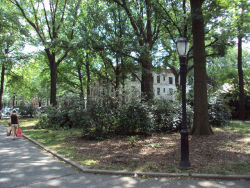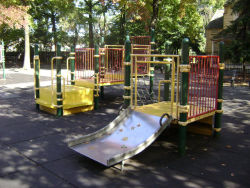Margaret I. Carman Green - Weeping Beech
Bowne House
Bowne House, built by John Bowne around 1661 and set within Weeping Beech Park in Flushing, Queens, is one of the oldest structures in the city. Once used by the Quakers as a secret house of worship, this wood-frame English colonial “saltbox” is a quintessential reminder of our nation’s religious history.
John Bowne (1628-1695) left Boston and his ties to the Boston Congregational Church to settle in Flushing, where he built the original portion of this house and raised a family with his wife Hannah, a practicing Quaker. He allowed his house to be used as a place of worship for Quakers until 1662, when he was arrested, imprisoned and fined at the order of Peter Stuyvesant, Director General of New Netherlands. Under Stuyvesant’s rule, only worship within the Dutch Reformed Church was permitted in the colony of New Amsterdam. Upon his arrest, Bowne was deported to Holland, where he was tried before a panel of officials from the Dutch West India Company. Bowne argued that he was guaranteed freedom of worship by virtue of the community’s agreement with the Dutch government. The officials agreed, setting him free. This episode marked one of the earliest legal tests of religious freedom in the colonies.
John Bowne’s defiance of Governor Stuyvesant reinforced a strong desire for religious freedom in the local community. A few years earlier, in 1657, 30 local men signed the “Flushing Remonstrance” a letter to the Governor declaring their support for tolerance and freedom of conscience for all. These same sentiments were later echoed in the first amendment of the United States Constitution. A large stone on the Bowne House property commemorates the 300th anniversary of the Remonstrance.
When the British took control of New Amsterdam in 1664, they ruled with greater tolerance toward religious practices, if only to appease the colonists. The Bowne House continued to serve openly as a place of worship for the Quakers for thirty years until 1694, when the Friends’ Meeting House of Flushing was built. During the time of the American Civil War (1861-65), the house was rumored to be one of the stops on the Underground Railroad.
The house was occupied by nine successive generations of Bownes and underwent several modifications. The original portion of the house, built in 1661, consists of a kitchen and an upstairs bedroom. Historic materials that make up the original house include a mortar made of mud, straw and animal bone. Additions were built in 1680 and 1691, and in 1830, the roof was raised and the north wing added. The steep roof with three dormer windows reflects the earlier influences of medieval northern European architecture.
Between 1945, when the last Bowne descendant lived in the house, and 2009, the Bowne House Historical Society assumed ownership of the house and its collection of documents, furniture and ephemera. In 2009, the house was deeded to the New York City Department of Parks & Recreation, and it will continue to operate as a museum under the leadership of the Bowne House Historical Society.
Several landmarks to religious freedom sit on or near the grounds of the Bowne House. Across the street from the Bowne House sits a large boulder that commemorates the grove of trees where George Fox, founder of the Quakers, preached before hundreds of followers. A rare example of colonial architecture in New York City, Bowne House marks a pivotal point in the nation’s evolution toward religious tolerance.
The Bowne House is owned by the New York City Department of Parks & Recreation, operated by the Bowne House Historical Society, and is a member of the Historic House Trust of New York City.
Check out your park's Vital Signs
Clean & Safe
Green & Resilient
Empowered & Engaged Users
Share your feedback or learn more about how this park is part of a
Vital Park System



